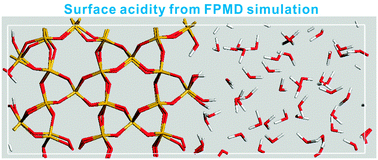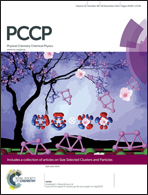Surface acidity of quartz: understanding the crystallographic control
Abstract
We report a first principles molecular dynamics (FPMD) study of surface acid chemistry of the two growth surfaces of quartz, (10![[1 with combining macron]](https://www.rsc.org/images/entities/char_0031_0304.gif) 0) (including Alpha and Beta terminations) and (10
0) (including Alpha and Beta terminations) and (10![[1 with combining macron]](https://www.rsc.org/images/entities/char_0031_0304.gif) 1) facets. The interfacial hydration structures are characterized in detail and the intrinsic pKas of surface silanols are evaluated using the FPMD based vertical energy gap method. The calculated acidity constants reveal that every surface termination shows a bimodal acid–base behavior. It is found that all doubly-protonated forms (i.e. SiOH2) on the three terminations have pKas lower than −2.5, implying that the silanols hardly get protonated in a common pH range. The pKas of surface silanols can be divided into 3 groups. The most acidic silanol is the donor SiOH on the (10
1) facets. The interfacial hydration structures are characterized in detail and the intrinsic pKas of surface silanols are evaluated using the FPMD based vertical energy gap method. The calculated acidity constants reveal that every surface termination shows a bimodal acid–base behavior. It is found that all doubly-protonated forms (i.e. SiOH2) on the three terminations have pKas lower than −2.5, implying that the silanols hardly get protonated in a common pH range. The pKas of surface silanols can be divided into 3 groups. The most acidic silanol is the donor SiOH on the (10![[1 with combining macron]](https://www.rsc.org/images/entities/char_0031_0304.gif) 0)-beta surface (pKa = 4.8), the medium includes the germinal silanol on (10
0)-beta surface (pKa = 4.8), the medium includes the germinal silanol on (10![[1 with combining macron]](https://www.rsc.org/images/entities/char_0031_0304.gif) 0)-alpha and the outer silanol on (10
0)-alpha and the outer silanol on (10![[1 with combining macron]](https://www.rsc.org/images/entities/char_0031_0304.gif) 1) (pKa = 8.5–9.3) and the least acidic are inner silanols on the (10
1) (pKa = 8.5–9.3) and the least acidic are inner silanols on the (10![[1 with combining macron]](https://www.rsc.org/images/entities/char_0031_0304.gif) 1)-facet, acceptor SiOH on (10
1)-facet, acceptor SiOH on (10![[1 with combining macron]](https://www.rsc.org/images/entities/char_0031_0304.gif) 0)-beta, and the secondly-deprotonated OH (i.e. Si(O–)(OH)) on (10
0)-beta, and the secondly-deprotonated OH (i.e. Si(O–)(OH)) on (10![[1 with combining macron]](https://www.rsc.org/images/entities/char_0031_0304.gif) 0)-alpha (pKa > 11.0). With the pKa values, we discuss the implication for understanding metal cations complexing on quartz surfaces.
0)-alpha (pKa > 11.0). With the pKa values, we discuss the implication for understanding metal cations complexing on quartz surfaces.


 Please wait while we load your content...
Please wait while we load your content...